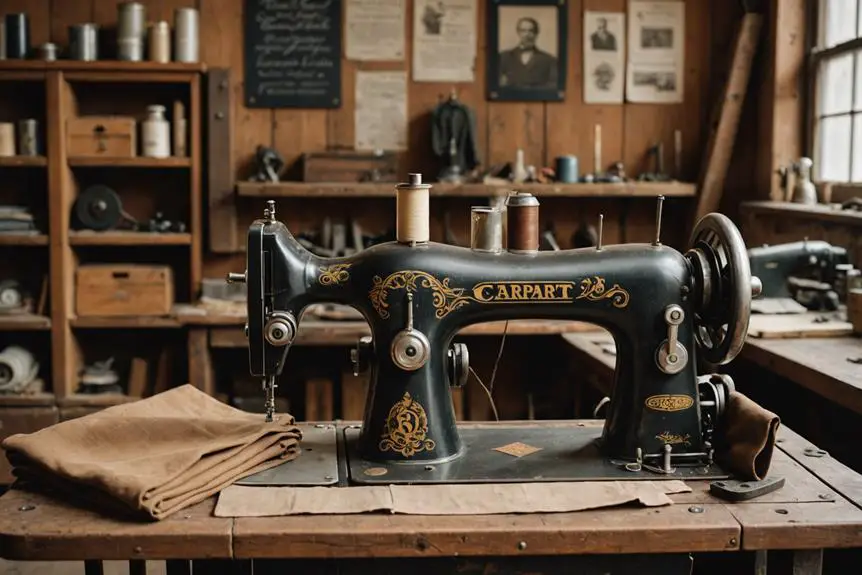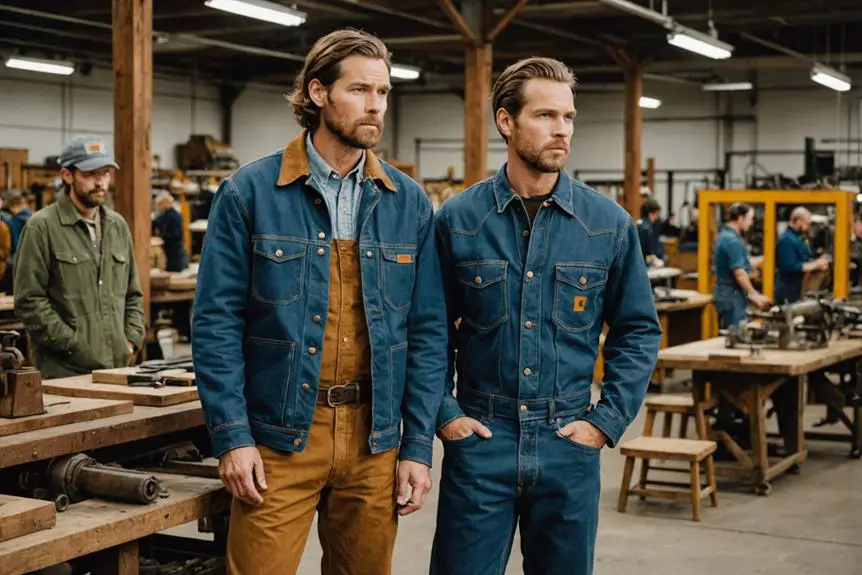Carhartt began its journey in 1882 as a wholesale furniture business in Detroit but pivoted to work apparel in 1898 after listening to the needs of railroad workers. The brand quickly established itself as a symbol of quality and durability, expanding its reach internationally by 1925. Despite facing challenges during the Great Depression, Carhartt remained dedicated to producing reliable garments, which helped it endure through resilience and community support. Over the years, Carhartt has continually innovated its product offerings, actively responding to customer feedback and evolving market demands. Today, it boasts a significant global presence, skillfully navigating modern fashion challenges while staying true to its storied legacy. Delving deeper into its history will unveil more about its evolution and contemporary strategies in the fashion industry.
Origins and Early Development

Carhartt began its journey in 1882 when Hamilton Carhartt established the company in Detroit, Michigan, initially as a wholesale furniture business. However, by 1898, recognizing the need for quality work wear, Carhartt pivoted to manufacturing durable work apparel. This decision was greatly influenced by direct consultations with railroad workers, who provided insights into their specific clothing needs. Carhartt's commitment to creating functional, sturdy garments quickly established a reputation for quality.
By 1925, the company had expanded its global footprint with production plants in cities like Liverpool, Vancouver, Paris, and New York. This expansion underscored Carhartt's ambition and ability to adapt to different markets while maintaining its core values of authenticity and durability.
Despite facing considerable challenges during the Great Depression, including workforce reductions and the closure of key locations, Carhartt remained resilient. The company's family-owned structure allowed it to navigate these difficulties while staying true to its mission of providing reliable work apparel. Over 130 years, Carhartt has evolved but consistently honored its legacy of durability and authenticity, ensuring its place in the workwear industry.
Economic Challenges and Resilience
Amidst the turbulent economic landscape of the 1920s and 1930s, Carhartt faced formidable challenges that tested its resilience and commitment to quality. The stock market crash of 1929 almost brought the company to its knees, but the determination of Hamilton Carhartt and his sons preserved it through this economic adversity. During the Great Depression, Carhartt upheld workers' rights, demonstrating resilience by continuing to support employees even amid significant financial distress.
Here are four key factors that contributed to Carhartt's survival:
- Commitment to Quality and Durability: Carhartt's reputation for producing reliable workwear fostered a loyal customer base.
- Leadership Change: After Hamilton's death in 1937, Wylie Carhartt guided the company through tough times, implementing strategic initiatives like the Back to the Land program.
- Adaptability: The ability to innovate and adjust product offerings helped the brand navigate the challenges posed by the Cotton Depression and the Great Depression.
- Community Engagement: Maintaining strong ties within the communities they served reinforced customer loyalty and support.
This combination of factors solidified Carhartt's legacy during a challenging era.
Innovation and Product Evolution

Emerging from the economic challenges of the 1920s and 1930s, the evolution of Carhartt's product offerings reflects a strategic response to the needs of its customers and the demands of the marketplace. Carhartt's commitment to innovation began with the introduction of saddle blanket-lined products in the late 1930s, designed for year-round wear and comfort. The early 1960s saw the launch of the Ranch Wear line, which featured acrylic pile linings that enhanced warmth and comfort, catering to outdoor workers.
In 1965, Carhartt introduced quilted lining, a feature that became standard across various product lines, greatly improving insulation in their workwear. This innovation laid the groundwork for the Extremes line, launched in 1998, which utilized a 1000-denier nylon shell specifically designed for severe cold and wet conditions. This move showcased Carhartt's dedication to producing extreme weather gear tailored to demanding environments.
Throughout its history, Carhartt has prioritized customer feedback, leading to the continuous product evolution that results in durable garments. This responsiveness guarantees that Carhartt remains a trusted brand for those who rely on functional workwear in challenging conditions.
Global Expansion and Market Presence
Expanding its footprint globally, Carhartt has strategically positioned itself in diverse markets since 1909, establishing a significant presence in cities like Atlanta, Liverpool, Paris, and Toronto. Under the leadership of the President of Carhartt, Mark Valade, the brand has further penetrated the European market and evolved into a formidable global e-commerce company.
Key elements of Carhartt's expansion strategy include:
- Collaborating with influencers to enhance brand visibility.
- Conducting extensive market research to understand customer preferences.
- Maintaining a robust retail store presence alongside online sales.
- Diversifying product lines with Carhartt Work In Progress to appeal to the streetwear segment.
With production primarily in America and some items sourced from Mexico, Carhartt has effectively built a global supply chain. In 2021, the brand reported impressive revenue of $800 million, showcasing its strong financial growth and sustained market presence. This combination of honest value and strategic positioning has allowed Carhartt to thrive across various professions and lifestyles, ensuring its relevance in an increasingly competitive landscape.
Leadership Changes and Future Outlook

Leadership changes at Carhartt have marked a pivotal moment in the company's evolution, reflecting both continuity and change. Linda Hubbard's appointment as the first non-family president in 2013 set the stage for a new era. In 2024, she took the helm as CEO, while Mark Valade retained his role as Executive Chairman. This combination guarantees a balance between fresh leadership and the enduring family legacy that has characterized Carhartt for four generations.
The company's operations in Kentucky and Tennessee remain a cornerstone of its identity, supporting local economies through robust manufacturing. As Carhartt looks to the future, its vision emphasizes adaptability and innovation in an ever-evolving market landscape, without a rigid blueprint for success.
Here's a snapshot of Carhartt's current leadership and outlook:
| Year | Leadership Change | Future Focus |
|---|---|---|
| 2013 | Linda Hubbard as President | Family legacy preservation |
| 2024 | Hubbard becomes CEO | Innovation in manufacturing |
| Mark Valade as Chairman | Building a better world | |
| Adaptability | ||
| Market responsiveness |
This leadership dynamic positions Carhartt to navigate challenges while honoring its rich history.
Frequently Asked Questions
What Was Carhartt Originally Made For?
Carhartt was originally made for manual laborers, focusing on durable work clothing. Its early designs prioritized functionality and protection, ensuring workers had reliable apparel suited for tough conditions, reinforcing the brand's commitment to quality and practicality.
How Did Carhartt Get so Popular?
Carhartt's popularity surged through strategic marketing, collaborations with designers, and its embrace of urban culture. By aligning with subcultures like hip-hop and skateboarding, it transformed from workwear to a fashionable staple, appealing to diverse consumers.
What Was Carhartt Original Use?
Carhartt's original use was to provide durable work clothing designed specifically for manual laborers. Its heavy-duty jackets and overalls catered to the demanding needs of workers, ensuring they had reliable and long-lasting garments for tough environments.
What Does the Carhartt Symbol Stand For?
The Carhartt symbol represents quality, durability, and heritage. Its colors convey happiness, purity, passion, and loyalty, reflecting the brand's commitment to workwear and its connection to the hardworking individuals who wear their products.





I don’t think the title of your article matches the content lol. Just kidding, mainly because I had some doubts after reading the article.
Your article helped me a lot, is there any more related content? Thanks!
Insightful read! My friend almost bought a bad car from an auction, and I avoided a flooded car thanks to a detailed report. I used a site I found recently to check the vehicle‚is history ‚the accident records, title issues, and auction details were all included. Could be a lifesaver for anyone buying used. Here‚is the link: https://vinifycheck.com/vin-check
Your article helped me a lot, is there any more related content? Thanks!